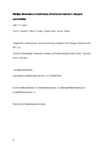Multiple dimensions of biodiversity drive human interest in tide pool communities
| dc.contributor.author | Fairchild, TP | |
| dc.contributor.author | Fowler, MS | |
| dc.contributor.author | Pahl, Sabine | |
| dc.contributor.author | Griffin, JN | |
| dc.date.accessioned | 2020-05-19T16:24:05Z | |
| dc.date.issued | 2018-12 | |
| dc.identifier.issn | 2045-2322 | |
| dc.identifier.issn | 2045-2322 | |
| dc.identifier.other | 15234 | |
| dc.identifier.uri | http://hdl.handle.net/10026.1/15690 | |
| dc.description | No embargo required | |
| dc.description.abstract |
<jats:title>Abstract</jats:title><jats:p>Activities involving observation of wild organisms (e.g. wildlife watching, tidepooling) can provide recreational and learning opportunities, with biologically diverse animal assemblages expected to be more stimulating to humans. In turn, more diverse communities may enhance human interest and facilitate provisioning of cultural services. However, no experimental tests of this biodiversity-interest hypothesis exist to date. We therefore investigated the effects of different dimensions of animal biodiversity (species richness, phyletic richness and functional diversity) on self-reported interest using tide pools as a model system. We performed two experiments by manipulating: (1) the richness of lower (species) and higher taxonomic levels (phyla) in an image based, online survey, and (2) the richness of the higher taxonomic level (phyla) in live public exhibits. In both experiments, we further quantified functional diversity, which varied freely, and within the online experiment we also included the hue diversity and colourfulness arising from the combination of organisms and the background scenes. Interest was increased by phyletic richness (both studies), animal species richness (online study) and functional diversity (online study). A structural equation model revealed that functional diversity and colourfulness (of the whole scene) also partially mediated the effects of phyletic richness on interest in the online study. In both studies, the presence of three of four phyla additively increased interest, supporting the importance of multiple, diverse phyla rather than a single particularly interesting phylum. These results provide novel experimental evidence that multiple dimensions of biodiversity enhance human interest and suggest that conservation initiatives that maintain or restore biodiversity will help stimulate interest in ecosystems, facilitating educational and recreational benefits.</jats:p> | |
| dc.format.extent | 15234- | |
| dc.format.medium | Electronic | |
| dc.language | en | |
| dc.language.iso | en | |
| dc.publisher | Springer Science and Business Media LLC | |
| dc.subject | Animals | |
| dc.subject | Behavior Observation Techniques | |
| dc.subject | Behavior, Animal | |
| dc.subject | Biodiversity | |
| dc.subject | Biota | |
| dc.subject | Classification | |
| dc.subject | Demography | |
| dc.subject | Ecosystem | |
| dc.subject | Human Activities | |
| dc.subject | Humans | |
| dc.subject | Learning | |
| dc.subject | Recreation | |
| dc.title | Multiple dimensions of biodiversity drive human interest in tide pool communities | |
| dc.type | journal-article | |
| dc.type | Journal Article | |
| dc.type | Research Support, Non-U.S. Gov't | |
| plymouth.author-url | https://www.ncbi.nlm.nih.gov/pubmed/30323240 | |
| plymouth.issue | 1 | |
| plymouth.volume | 8 | |
| plymouth.publication-status | Published online | |
| plymouth.journal | Scientific Reports | |
| dc.identifier.doi | 10.1038/s41598-018-33155-x | |
| plymouth.organisational-group | /Plymouth | |
| plymouth.organisational-group | /Plymouth/Faculty of Health | |
| plymouth.organisational-group | /Plymouth/REF 2021 Researchers by UoA | |
| plymouth.organisational-group | /Plymouth/REF 2021 Researchers by UoA/UoA04 Psychology, Psychiatry and Neuroscience | |
| plymouth.organisational-group | /Plymouth/REF 2021 Researchers by UoA/UoA04 Psychology, Psychiatry and Neuroscience/UoA04 Psychology, Psychiatry and Neuroscience MANUAL | |
| plymouth.organisational-group | /Plymouth/Research Groups | |
| plymouth.organisational-group | /Plymouth/Research Groups/Centre for Brain, Cognition and Behaviour (CBCB) | |
| plymouth.organisational-group | /Plymouth/Research Groups/Centre for Brain, Cognition and Behaviour (CBCB)/Behaviour | |
| plymouth.organisational-group | /Plymouth/Research Groups/Institute of Health and Community | |
| plymouth.organisational-group | /Plymouth/Users by role | |
| dc.publisher.place | England | |
| dcterms.dateAccepted | 2018-09-10 | |
| dc.rights.embargodate | 2020-5-21 | |
| dc.identifier.eissn | 2045-2322 | |
| dc.rights.embargoperiod | Not known | |
| rioxxterms.versionofrecord | 10.1038/s41598-018-33155-x | |
| rioxxterms.licenseref.uri | http://www.rioxx.net/licenses/all-rights-reserved | |
| rioxxterms.licenseref.startdate | 2018-12 | |
| rioxxterms.type | Journal Article/Review |


